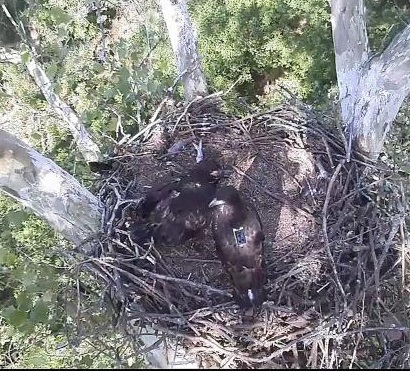Bald Eagle Banding and Transmitter Attachment at Duke Farms
Two bald eaglets at the site of our Eagle Cam at Duke Farms were recently banded by biologists from Conserve Wildlife Foundation (CWF) and New Jersey Department of Environmental Protection, Endangered and Nongame Species Program (NJDEP ENSP).
This year’s banding was special, as in addition to a band the male eaglet was also fitted with a transmitter which will allow him to be tracked on our Eagle Trax page.

Kathy Clark, (NJDEP ENSP), and Larissa Smith (CWF) wrote about the experience, and the benefits of transmitters on the Duke Farms blog. Their FAQ’s are reprinted below.
Duke Farm Eagle Cam Transmitter FAQs
What is the data used for?
Data from the transmitter is used to learn about habitat use by non-breeding, sub-adult eagles as they move around for the first five years of life. The recorded locations each day will be used with other eagles’ data to provide information on habitats and potential threats. Data on critical habitats is considered by the NJDEP in the course of development permit review, long term planning, land acquisition, and projects that could conflict with eagles such as wind turbine siting. Overnight locations help biologists identify sites that could be communal roosts, which are worthy of long term protection to benefit the regional eagle population.
Why can’t wildlife just be left alone? Why do we need to track them?
Unfortunately, due to human interference over many decades, eagles need our help. Regulatory protection for healthy land and water is important, but not enough on its own. Knowing the health of our eagle population, and being able to identify problems, are necessary parts of being responsive and adaptive. The Duke Farms eagle nest is part of a huge success story, but there was a lot of hands-on work along the way. Read more about that work, done through the Bald Eagle Project.
How much does the transmitter weigh?
The satellite tag weighs 70 grams, which is about 2% of an eagle’s weight. The USGS Bird Banding Lab has a guideline allowing a tag to weigh 3% of a bird’s weight.
Will the transmitter be on for its entire life?
The tag has a lifespan of approximately 5 years. The harness’s weak spot is the attachment knot, which should last for the 5 year period.
Does it bother the eagle?
We have the luxury of the webcam, so we can watch how the eagles react to the leg bands (on both birds) and the sat tag on the male. In the first few days there seemed to be no reaction at all to the “bling.” In other species on webcams, such as peregrine falcons, they seem to give no attention to leg bands or transmitter attachments.
Will the straps get caught in a tree on a limb or something?
The harness for the transmitter was carefully designed and fitted so that it does not interfere with the eagle’s movements at all.
Do the parents notice something different?
The adults are most likely notice the transmitter, but because it doesn’t pose a threat to them or the young, they aren’t alarmed by it. After attaching a transmitter to a chick the adults have always come back to the nest and shown normal behavior.
Does the reflective nature of the solar panel annoy the parents or make it a target?
This type of tag and harness has been used successfully on hundreds of bald and golden eagles. It is low-profile and is carried for years with no ill effects.
For more information see:
- Duke Farm’s blog post on the eagle banding and transmitter
- CWF Eagle Trax
- CWF Eagle Cam
- CWF Bald Eagle Project
Discover more from Conserve Wildlife Foundation of NJ
Subscribe to get the latest posts sent to your email.